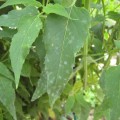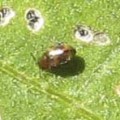Slimy mollusks with no outer shell, similar to a snail. They can be 1/4″ long when young, and up to 10″ long fully grown. They have two tentacles, which are their eyes. They come in all colors (brown, gray, purple, black, white, yellow) as well as spotted.
Their eggs are clusters of 25 translucent, white round or oval eggs filled with a watery liquid. Egg clusters are laid in spring and early summer in soil cracks, under mulch or rocks, or under flowerpots. The eggs hatch in about 3 weeks to a month. There can be up to two generations in one season, in humid regions.
Species & Taxonomy
- Kingdom:
- Phylum: Mollusca
- Class: Gastropoda
- Order:
- Family: There are various families of slugs, which are not closely related, despite all being slimy, shell-less molluscs:
- Onchidiacea
- Soleolifera
- many from within Sigmurethra
- Genus Species:
- Gray Garden Slug: Agriolimax reticulatus
Plants Affected
Seedlings of all plants are at risk, and particularly pea seedlings. You can cover them until they’re about 6″ high, using plastic jugs or bells. leave caps off for ventilation, and make sure no slugs are inside when you put the bell on!
Nearly all crops are affected. Artichokes, asparagus, basil, bean, brassicas, celeriac, celery, chard, cucumber, eggplant, greens, lettuce, onion, peas, pepper seedlings, sage, squash, strawberry, most fruit trees
Plants Unaffected
Achillea, ageratum, alyssum, arabis, armeria, aster, astilbe, calendula, campanula, cosmos, dianthus, diecentra, eschscholzia, galium, hemerocallis, iberis, kniphofia, lobelia, mentha, nasturtium, paenoia, penstemon, phlox, portulaca, potentilla, ranunculus, rudbecia, saxifraga, sedum, thymus, verbena vinca, viola, zinnia
Geography
Widespread, but are one of the top pests of the western US, particularly the Pacific North West, because they thrive below 75 degrees F.
Signs & Symptoms
- Trails of slime on leaves and soil or sidewalks.
- Large, ragged holes in leaves, fruits, and stems, starting at soil and working up. They can consume an entire plant in one evening. On large plants you will notice large, irregular holes in the leaves, or just the midribs will be left. On fruits, they will chew holes into the flesh, like strawberries and tomatoes, that are near the soil.
- You can spot them feeding 2 hours after sundown to 2 hours before sun up, although they are dormant in the winter, except in temperate areas. They will emerge from dormancy when teh soil thaws in the spring. Go out in the garden on a wet, warm evening with a flashlight to see them in action.
Prevention & Control
A four-pronged approach is recommended with slugs, since no one method will be completely effective:
- Change the environment to be less hospitable to the slugs
- Provide habitat and attract natural predators of slugs
- Handpick frequently
- Disperse traps around the problem areas
Environmental Controls:
Habitat:
- Reduce slug habitat (garden debris, bricks, boards, garden clippings, weeds). Kill egg clusters that you find.
- Improve habitats for beneficial insects and natural predators by always having an area planted with a cover crop.
Temperature & Humidity:
Wet, warm springs can be very bad. Damage will taper off when summer gets hot and dry, coming back in late fall.
Mulching:
- Use mulches that irritate slugs: shredded bark, crushed rock, cinders.
- Rake up surface mulch at the start of the growing season, then hold off applying new mulch until the soil has warmed above 75 degrees F. The slugs go away to cooler, moister areas at about this temp. Limit mulch depth to 1″, which will still protect the soil, and conserve moisture, but the mulch itself will not stay moist and good for slugs.
- If using grass clippings, let them dry before applying.
Cultivation Practices:
- Watering in the morning instead of the evening has been shown to reduce slug damage to leaves. I think it’s because the leaves are less turgid (water-filled) when the slugs are feeding through the night.
- Cultivate soil in spring to destroy dormant slugs and eggs.
Barriers
Physical Barriers:
- When you use physical barriers, stick some traps inside the protected zone so that you can catch the slugs that are present when you put up the barriers.
- Plant distasteful plants around the stuff the slugs like to eat. See list above, “Plants Unaffected”. Especially effective are fennel, garlic, and rosemary.
- Aluminum Screening: Push 3 ” high strips of aluminum screening about 1″ into the soil, leaving 2″ above ground. Bend the top of the screen outward, away from the bed, and remove two strands from the edge so it’s rough. Barbed wire for slugs 🙂
- Copper or Zinc: tack 2″ strips of copper or zinc-galvanized flashing around the outside of beds, about 1″ from the top acts like an electric fence. Snail Bar is a commercial product available to purchase, made in Ventura, California, by Custom Copper. It is better than homemade for trees because it expands as the tree trunk grows.
Scratchy Barriers:
- apply scratchy barriers so that there is a continuous band around the plants to be protected. Less effective when wet, they should be reapplied after rainfall.
- Egg Shells: spread crushed egg shells around plant bases
- Hardware cloth: tack strips of hardware cloth onto top edges of bed, extending 2″ above the edge so that the sharp points along the top edge.
- Diatomaceous Earth: sprinkle DE around the plant base and work slightly into the soil.
- Wood Ashes: sprinkle around plant bases; will burn leaves, so don’t get any on the plants.
- Sweet Gum Balls: seed pods from liquid amber trees
Toxic Barriers:
- Soap: pastes or flakes of soap
- Salt: this old-time favorite is not recommended anymore because the salt is bad for your soil and plant health.
- Coffee Grounds: Early research is showing that a 1% solution of caffeine will kill slugs and snails. Surrounding the plant with coffee grounds may deter the slugs. Use experimentally, as it may be detrimental to beneficial insects.
- Iron Phosphate: slugs die after eating this mined material. It is nontoxic to humans and animals, but some commercially available products are not acceptable by certified organic growers because they contain a certain chelating agent.
- Metaldehyde: TOXIC to people and pets; not approved for organic growing operations.
Sprays & Dusts
- Vinegar & water spray (2 parts vinegar to 1 part water), although can harm plants. Reduce vinegar (1 part vinegar to 1 part water) for less plant damage; still is said to be effective against snails.
- Wormwood tea
- Garlic powder or raw garlic, according to researchers in India, contains allicin that kills snails; probably would also work against slugs.
- Pestoban: herbal concoction from India that contains three medicinal herbs; found to be effective at very low doses
Traps
- Liquid Traps: sink a container with fairly straight sides (bowl, shallow pan, yogurt container, coffee can) that is about 4″ deep into the soil, with 1″ showing above the soil. Fill the container with about 1″ of liquid. Empty slugs daily; refill after rainfalls. Good liquids to attract slugs:
- Stale beer
- Yeast water (1 teaspon dry yeast in 1/4 cup water)
- Oregon Slug Bait: 1 tablespoon granulated yeast and 2 tablespoons of sugar into 3 cups water
- Plantain (weed) is a trap crop, but can be invasive in some regions.
- Board Trap: set a wide board about 1″ off the ground in an infested area. During the daytime the slugs will use this as shelter and allow you to easily catch them and dispose of them.
- Gutter Trap: use an aluminumm gutter around the garden beds, coated with ivory soap. Apparently the slugs get stuck in the soap. Dispose of trapped slugs daily.
Natural Enemies
Insects:
- Parasitic Flies:
- Small-headed flies (Acroceridae)
- Bee flies (Bombyliidae)
- Midges (Chironomidae)
- Thick-headed flies (Conopidae)
- Cryptochaetid flies
- Tangle-veined flies (Nemestrinidae)
- Humpbacked flies (Phoridae)
- Big-headed flies (Pipunculidae)
- Pyrgotid flies
- Tachinid flies
- Ground Beetles (Scaphinotus spp.)
- Lightning Bug Larvae
- Rove Beetles (Ocypus spp.)
Animals:
- Chickens
- Ducks
- Birds
Reptiles:
- Turtles
- Salamanders
- Grass Snakes
- Garter Snakes



